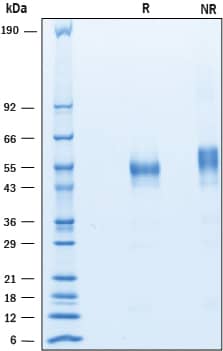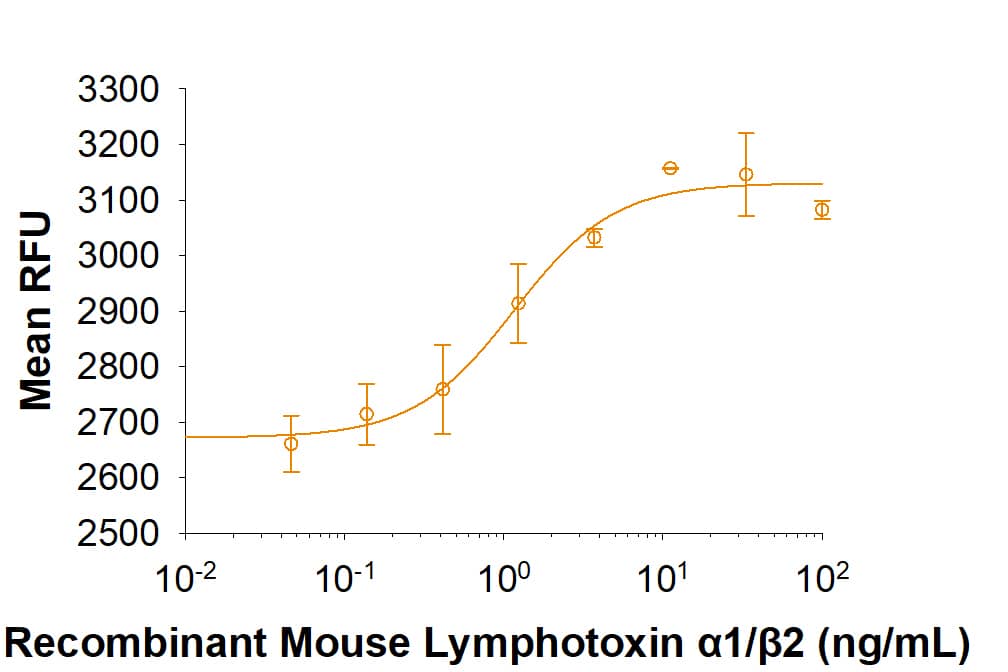Recombinant Mouse Lymphotoxin alpha1/beta2 Protein
R&D Systems, part of Bio-Techne | Catalog # 9968-LY

Key Product Details
Source
Accession #
Structure / Form
Conjugate
Applications
Product Specifications
Source
| Mouse LT alpha (Lys59-Leu202) Accession # P09225 |
GGGGS |
Mouse LT beta (Leu153-Gly306) Accession # P41155 |
GGGGS |
Mouse LT beta (Leu153-Gly306) Accession # P41155 |
Purity
Endotoxin Level
N-terminal Sequence Analysis
Predicted Molecular Mass
SDS-PAGE
Activity
The ED50 for this effect is 0.3-2.1 ng/mL.
Scientific Data Images for Recombinant Mouse Lymphotoxin alpha1/beta2 Protein
Recombinant Mouse Lymphotoxin alpha1/beta2 Protein Bioactivity
Recombinant Mouse Lymphotoxin alpha1/ beta2 (Catalog # 9968-LY) induces NIH‑3T3 mouse embryonic fibroblast cell proliferation. The ED50 for this effect is 0.3-2.1 ng/mL.Recombinant Mouse Lymphotoxin alpha1/beta2 Protein SDS-PAGE
2 μg/lane of Recombinant Mouse Lymphotoxin alpha1/beta2 was resolved with SDS-PAGE under reducing (R) and non-reducing (NR) conditions and visualized by Coomassie® blue staining, showing bands at 42-63 kDa.Formulation, Preparation and Storage
Carrier Free
What does CF mean?CF stands for Carrier Free (CF). We typically add Bovine Serum Albumin (BSA) as a carrier protein to our recombinant proteins. Adding a carrier protein enhances protein stability, increases shelf-life, and allows the recombinant protein to be stored at a more dilute concentration. The carrier free version does not contain BSA.
What formulation is right for me?In general, we advise purchasing the recombinant protein with BSA for use in cell or tissue culture, or as an ELISA standard. In contrast, the carrier free protein is recommended for applications, in which the presence of BSA could interfere.
Carrier: 9968-LY
| Formulation | Lyophilized from a 0.2 μm filtered solution in PBS with BSA as a carrier protein. |
| Reconstitution | Reconstitute at 500 μg/mL in PBS. |
| Shipping | The product is shipped at ambient temperature. Upon receipt, store it immediately at the temperature recommended below. |
| Stability & Storage |
|
Carrier Free: 9968-LY/CF
| Formulation | Lyophilized from a 0.2 μm filtered solution in PBS. |
| Reconstitution | Reconstitute at 500 μg/mL in PBS. |
| Shipping | The product is shipped at ambient temperature. Upon receipt, store it immediately at the temperature recommended below. |
| Stability & Storage |
|
Background: Lymphotoxin
References
- Lu, T.T. and J.L. Browning (2014) Front. Immunol. 5:47.
- Upadhyay, V. and Y.-X. Fu (2014) Cytokine Growth Factor Rev. 25:227.
- Gray, P.W. et al. (1984) Nature 312:721.
- Nedwin, G.E. et al. (1985) J. Cell Biochem. 29:171.
- Browning, J.L. et al. (1993) Cell 72:847.
- Ettinger R. et al. (1996) Proc. Natl. Acad. Sci. USA 93:13102.
- Cuff, C.A. et al. (1998) J. Immunol. 161:6853.
- Sudhamsu, J. et al. (2013) Proc. Natl. Acad. Sci. USA 110:19896.
- Crowe, P.D. et al. (1994) Science 264:707.
- Eldredge, J. et al. (2006) Biochemistry 45:10117.
- Kruglov, A.A. et al. (2013) Science 342:1243.
- Futterer, A. et al. (1998) Immunity 9:59.
- Koni, P.A. et al. (1997) Immunity 6:491.
- Ota, N. et al. (2011) Nat. Immunol. 12:941.
- Young, J. et al. (2010) Cytokine 51:78.
Alternate Names
Gene Symbol
Additional Lymphotoxin Products
Product Documents for Recombinant Mouse Lymphotoxin alpha1/beta2 Protein
Product Specific Notices for Recombinant Mouse Lymphotoxin alpha1/beta2 Protein
For research use only

